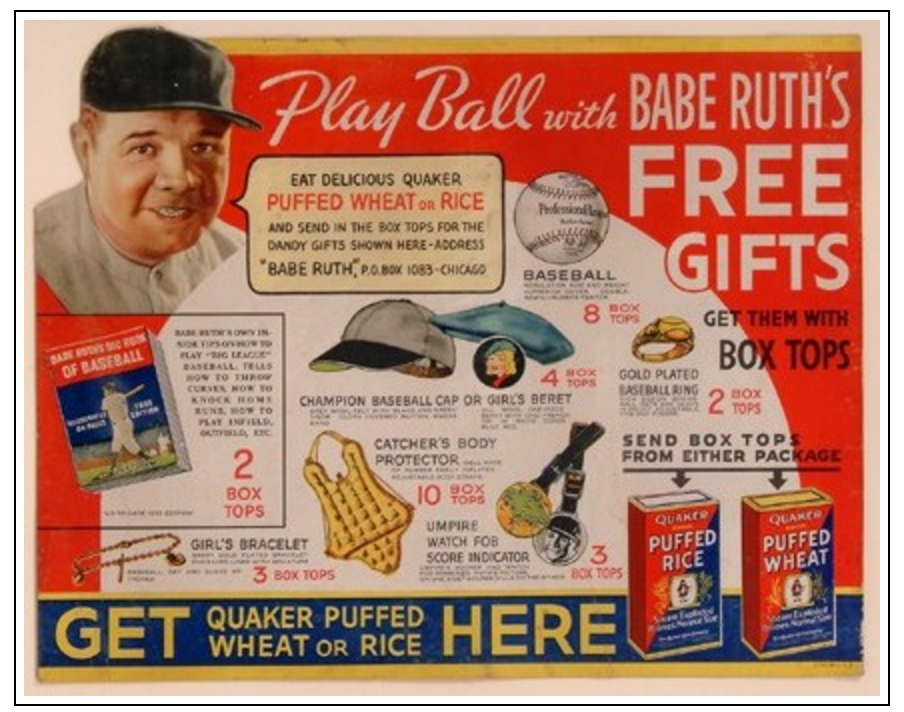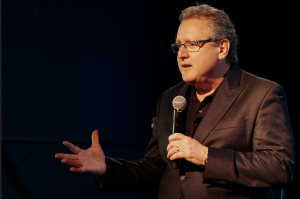
American baseball star Babe Ruth was among the first celebrity influencers. He made more money from his sponsorships than his sports career.
By Mark Schaefer
After uttering one sentence a few weeks ago, I was “fired” from a consulting job … before it even started. But it is an interesting tale and I wanted SOME good to come of it, so here it is — with a lesson about the future of advertising.
A (big big) company hired me to do a workshop on digital marketing trends and we had a “pre-call” to go over my proposed content. Here’s the statement that got me fired:
“I think we are gradually moving toward an ad-free world.”
The person on the other end of the phone audibly gasped. “Why would you say that?” she said with a panicky tone in her voice.
To explain, I compared my level of advertising consumption today versus five years ago.
- I watch more TV than ever, yet I only see commercials if I tune to the news or a sporting event. All of my other television consumption comes through a streaming subscription service like Amazon or Netflix.
- I subscribe to the online versions of four different newspapers. I never see ads.
- I listen to Sirius XM in the car. I never hear radio ads.
- I do not use an ad-blocker on my devices out of principle — I realize it takes away people’s jobs. But at least 30 percent of Americans don’t see digital ads either.
- The only places I regularly consume ads are podcasts (can’t block the ads) and Facebook (which explains Facebook’s impressive profitability).
I estimate that over five years, my advertising consumption has declined by 95 percent, and I’m not alone. In other words, we are moving, inexorably, toward an ad-free world, or at least a world with a dramatic decline in an audience that can be reached by ads. One New York advertising executive recently told me their world was “in crisis.” Right.
I could tell the call was not going well and I later learned that the person on the other end was responsible for the entire advertising budget for the Fortune 500 company! Whoops. No wonder she seemed a little defensive.
My presentation was “postponed” … and I’ve never heard from them again.
What do we have left?
But if I’m right about this observation (and I am), what’s the answer? There are still a lot of companies with fat ad budgets out there — where are they going to spend that money? The more I think about it, the more I’m convinced the answer is influence marketing.
Of course there are lots of other options like sponsored content, native advertising, and content marketing. And of course all ads are not really going away. But these alternatives maintain the traditional relationship where a company is talking to a person. And fundamentally, I think it’s a better way to do business when a person talks to a person.
Today, companies seem like detached institutions, but the people we love to follow on social media are our beloved, trusted friends. They make a difference. They cut through the noise. From startup companies to giants like Wal-Mart, everyone seems to be jumping on the influence marketing bandwagon.
However, moving promotion dollars into influence marketing is NOT as easy as moving your ad budget from TV to radio. Moving your budget into influence marketing is like moving your career from sales to engineering. The product might seem familiar, but you need an entirely new set of skills to succeed!
And this is why so much about influence marketing seems to be a struggle right now — many companies simply have a goal of stuffing their ads into the mouths of influencers. They’re not adjusting to the requirements of this new world, which is resulting in a lot of stumbling about.
I have a friend who works in marketing for a movie studio. Influence marketing has become a HUGE part of what they do, but even experienced companies fall into the ad-model trap. He told me that the ad agency associated with a film told him that their influencer (a YouTube star) needed to post about the movie on a Tuesday morning. The influencer refused, saying he never posts on Tuesday mornings and that his audience would think this was odd. The agency persisted, and again demanded that he post. He did it, and sure enough, the post fell flat. When he posted on one of his “regular times,” he attracted a huge level of engagement.
Clearly, we are in a new world.
The five benefits of influence marketing
The rules of marketing have seemingly turned upside-down, as the “spokespeople” call the shots. The results of influence marketing may be relatively unpredictable. The way we measure and budget for this kind of activity has changed dramatically. And yet, the potential benefits are undeniable … if you do it right.
Back in 2012, I wrote the first the first book on influence marketing, Return On Influence. At the end of the book I predicted that this would become a mainstream marketing practice within two years. This forecast was correct, and today influence marketing is the second-fastest-growing line item on marketing budgets (behind content marketing). It has become an industry unto itself as we see new programming emerge around social media influence instead of Hollywood talent. “Influence” is rapidly driving entirely new business models.
The research supports the power of influence marketing. When people share content about us online, they become advocates. Most people acknowledge that their purchasing decisions are affected by content they see shared online. In fact, they will trust content shared by an infleuntial stranger before they will trust your ads. Purchases resulting from influencer recommendations may equal eight times what the influencer purchased on their own.
Here are five benefits from influence marketing:
1. AWARENESS
For a start-up company, a product launch, or a new movie, there is no time to patiently build an actionable audience. In this situation, borrowing the audience of an influencer may be the only way to build awareness quickly if advertising is not the option it used to be.
2. LINKS
An influencer in many industries has a powerful web presence. Linking to your site might provide very valuable links that influence SEO results.
3. RESEARCH AND DEVELOPMENT
I recently published a case study on how Western Digital uses its most passionate advocates as a research and development department. Nobody cares about their products more, so why not give them a sneak peek at new ideas to get their input?
4. SALES
Without question, influencers can move the needle. There are many case studies that illustrate how the mere mention of a product by an influencer or a photo on Instagram can shoot sales through the roof.
5. STRATEGIC LEVERAGE
This may be the most important aspect of all, and a consideration overlooked by many. There are only so many “influencers” to go around, and they have the capacity to align themselves with a finite number of products. Lining up a long-term relationship with an influencer can mean a truly sustainable competitive advantage — you are securing a scarce resource for your company.
Influence marketing is a hot topic that will get even hotter as many other promotional options dry up. Just don’t get fired talking about it! What’s your take on winning in an ad-free world?
 Mark Schaefer is the chief blogger for this site, executive director of Schaefer Marketing Solutions, and the author of several best-selling digital marketing books. He is an acclaimed keynote speaker, college educator, and business consultant. The Marketing Companion podcast is among the top business podcasts in the world. Contact Mark to have him speak to your company event or conference soon.
Mark Schaefer is the chief blogger for this site, executive director of Schaefer Marketing Solutions, and the author of several best-selling digital marketing books. He is an acclaimed keynote speaker, college educator, and business consultant. The Marketing Companion podcast is among the top business podcasts in the world. Contact Mark to have him speak to your company event or conference soon.


